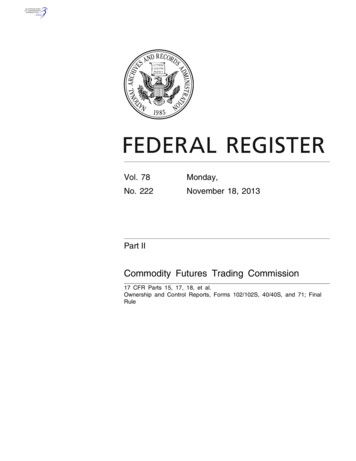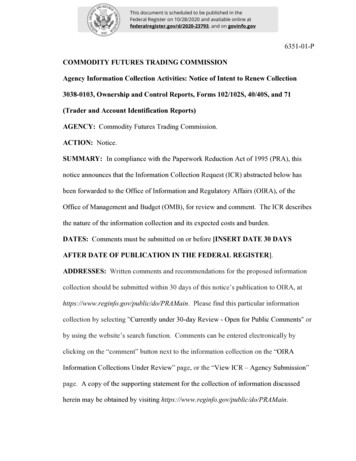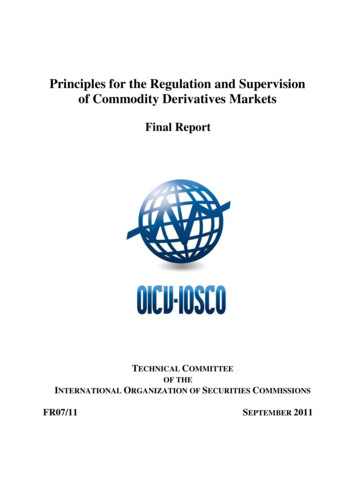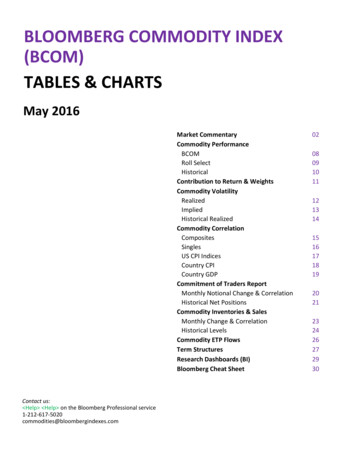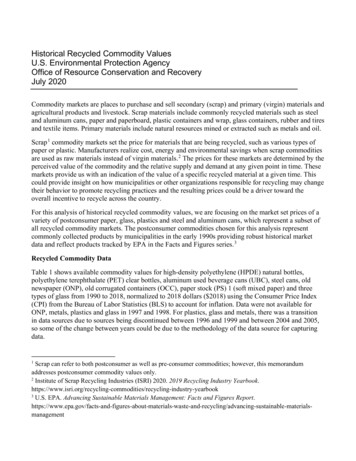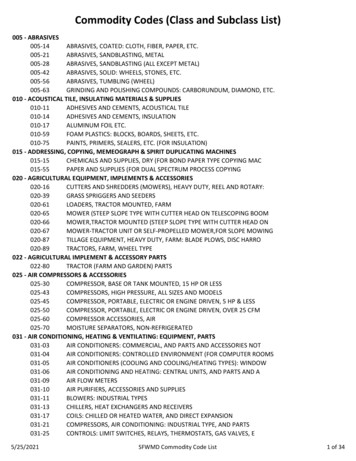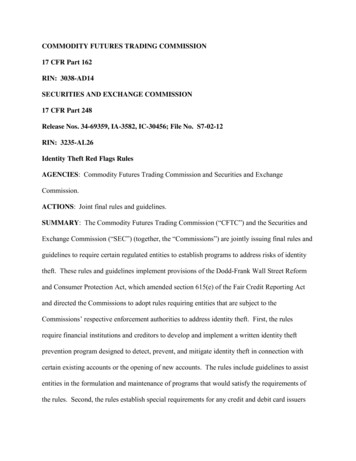
Transcription
COMMODITY FUTURES TRADING COMMISSION17 CFR Part 162RIN: 3038-AD14SECURITIES AND EXCHANGE COMMISSION17 CFR Part 248Release Nos. 34-69359, IA-3582, IC-30456; File No. S7-02-12RIN: 3235-AL26Identity Theft Red Flags RulesAGENCIES: Commodity Futures Trading Commission and Securities and ExchangeCommission.ACTIONS: Joint final rules and guidelines.SUMMARY: The Commodity Futures Trading Commission (“CFTC”) and the Securities andExchange Commission (“SEC”) (together, the “Commissions”) are jointly issuing final rules andguidelines to require certain regulated entities to establish programs to address risks of identitytheft. These rules and guidelines implement provisions of the Dodd-Frank Wall Street Reformand Consumer Protection Act, which amended section 615(e) of the Fair Credit Reporting Actand directed the Commissions to adopt rules requiring entities that are subject to theCommissions’ respective enforcement authorities to address identity theft. First, the rulesrequire financial institutions and creditors to develop and implement a written identity theftprevention program designed to detect, prevent, and mitigate identity theft in connection withcertain existing accounts or the opening of new accounts. The rules include guidelines to assistentities in the formulation and maintenance of programs that would satisfy the requirements ofthe rules. Second, the rules establish special requirements for any credit and debit card issuers
that are subject to the Commissions’ respective enforcement authorities, to assess the validity ofnotifications of changes of address under certain circumstances.DATES: Effective Date: May 20, 2013;Compliance Date: November 20, 2013.FOR FURTHER INFORMATION CONTACT: CFTC: Sue McDonough, Counsel, atCommodity Futures Trading Commission, Office of the General Counsel, Three LafayetteCentre, 1155 21st Street, NW, Washington, DC 20581, telephone number (202) 418-5132,facsimile number (202) 418-5524, e-mail smcdonough@cftc.gov; SEC: with regard toinvestment companies and investment advisers, contact Andrea Ottomanelli Magovern, SeniorCounsel, Amanda Wagner, Senior Counsel, Thoreau Bartmann, Branch Chief, or Hunter Jones,Assistant Director, Office of Regulatory Policy, Division of Investment Management, (202)551-6792, or with regard to brokers, dealers, or transfer agents, contact Brice Prince, SpecialCounsel, Joseph Furey, Assistant Chief Counsel, or David Blass, Chief Counsel, Office of ChiefCounsel, Division of Trading and Markets, (202) 551-5550, Securities and ExchangeCommission, 100 F Street, NE, Washington, DC 20549-8549.SUPPLEMENTARY INFORMATION:The Commissions are adopting new rules and guidelines on identity theft red flags forentities subject to their respective enforcement authorities. The CFTC is adding new subpart C(“Identity Theft Red Flags”) to part 162 of the CFTC’s regulations [17 CFR part 162] and theSEC is adding new subpart C (“Regulation S-ID: Identity Theft Red Flags”) to part 248 of theSEC’s regulations [17 CFR part 248], under the Fair Credit Reporting Act [15 U.S.C. 1681–1681x], the Commodity Exchange Act [7 U.S.C. 1–27f], the Securities Exchange Act of 19342
[15 U.S.C. 78a–78pp], the Investment Company Act of 1940 [15 U.S.C. 80a], and theInvestment Advisers Act of 1940 [15 U.S.C. 80b].TABLE OF CONTENTSI.BACKGROUND . 4II.EXPLANATION OF THE FINAL RULES AND GUIDELINES. 8A.Final Identity Theft Red Flags Rules . 81.Which Financial Institutions and Creditors Are Required to Have a Program . 92.The Objectives of the Program . 293.The Elements of the Program . 304.Administration of the Program . 32B.Final Guidelines . 341.Section I of the Guidelines–Identity Theft Prevention Program . 352.Section II of the Guidelines –Identifying Relevant Red Flags . 353.Section III of the Guidelines–Detecting Red Flags . 364.Section IV of the Guidelines–Preventing and Mitigating Identity Theft . 375.Section V of the Guidelines–Updating the Identity Theft Prevention Program . 386.Section VI of the Guidelines–Methods for Administering the Identity TheftPrevention Program . 387.Section VII of the Guidelines–Other Applicable Legal Requirements . 408.Supplement A to the Guidelines . 40C.III.Final Card Issuer Rules . 41RELATED MATTERS . 42A.Cost-Benefit Considerations (CFTC) and Economic Analysis (SEC) . 42B.Analysis of Effects on Efficiency, Competition, and Capital Formation . 61C.Paperwork Reduction Act . 62D.Regulatory Flexibility Act . 74IV.STATUTORY AUTHORITY AND TEXT OF AMENDMENTS . 813
I.BACKGROUNDThe growth and expansion of information technology and electronic communication havemade it increasingly easy to collect, maintain, and transfer personal information aboutindividuals. 1 Advancements in technology also have led to increasing threats to the integrity andprivacy of personal information. 2 During recent decades, the federal government has taken stepsto help protect individuals, and to help individuals protect themselves, from the risks of theft,loss, and abuse of their personal information. 3The Fair Credit Reporting Act of 1970 (“FCRA”), 4 as amended in 2003, 5 required severalfederal agencies to issue joint rules and guidelines regarding the detection, prevention, and1See, e.g., U.S. GOVERNMENT ACCOUNTABILITY OFFICE, INFORMATION SECURITY: FEDERALGUIDANCE NEEDED TO ADDRESS CONTROL ISSUES WITH IMPLEMENTING CLOUD COMPUTING(May 2010), available at http://www.gao.gov/new.items/d10513.pdf (discussing informationsecurity implications of cloud computing); DEPARTMENT OF COMMERCE, INTERNET POLICYTASK FORCE, COMMERCIAL DATA PRIVACY AND INNOVATION IN THE INTERNET ECONOMY: ADYNAMIC POLICY FRAMEWORK, at Section I (2010), available athttp://www.ntia.doc.gov/reports/2010/iptf privacy greenpaper 12162010.pdf (reviewing recenttechnological changes that necessitate a new approach to commercial data protection). See alsoFRED H. CATE, PRIVACY IN THE INFORMATION AGE, at 13–16 (1997) (discussing the privacy anddata security issues that arose during early increases in the use of digital data).2A recent survey found that in 2012, over 5% of Americans were victims of identity fraud. SeeJavelin Strategy & Research, 2013 IDENTITY FRAUD REPORT: DATA BREACHES BECOMING ATREASURE TROVE FOR FRAUDSTERS (Feb. 2013), available athttps://www.javelinstrategy.com/uploads/web brochure/1303.R 2013IdentityFraudBrochure.pdf;see also Comment Letter of Tyler Krulla (“Tyler Krulla Comment Letter”) (Apr. 27, 2012) (“Intoday’s technology driven world it is easier than ever for anyone to acquire and exploitsomeone’s identity and cause severe financial problems.”).3See, e.g., CONSUMER DATA PRIVACY IN A NETWORKED WORLD: A FRAMEWORK FORPROTECTING PRIVACY AND PROMOTING INNOVATION IN THE GLOBAL DIGITAL ECONOMY (Feb.2012), available at acy-final.pdf (a WhiteHouse proposal to establish a consumer privacy bill of rights); The President’s Identity TheftTask Force Report (Sept. 2008), available ort.pdf; Securities and Exchange Commission,ONLINE BROKERAGE ACCOUNTS: WHAT YOU CAN DO TO SAFEGUARD YOUR MONEY AND YOURPERSONAL INFORMATION, available at tm.4Pub. L. 91-508, 84 Stat. 1114 (1970), codified at 15 U.S.C. 1681–1681x.4
mitigation of identity theft for entities that are subject to their respective enforcement authorities(also known as the “identity theft red flags rules”). 6 Those agencies were the Office of theComptroller of the Currency (“OCC”), the Board of Governors of the Federal Reserve System(“Federal Reserve Board”), the Federal Deposit Insurance Corporation (“FDIC”), the Office ofThrift Supervision (“OTS”), the National Credit Union Administration (“NCUA”), and theFederal Trade Commission (“FTC”) (together, the “Agencies”). 7 In 2007, the Agencies issuedjoint final identity theft red flags rules. 8 At the time the Agencies adopted their rules, the FCRAdid not require or authorize the CFTC and SEC to issue identity theft red flags rules. Instead, theAgencies’ rules applied to entities that registered with the CFTC and SEC, such as futurescommission merchants, broker-dealers, investment companies, and investment advisers. 95See Fair and Accurate Credit Transactions Act of 2003, Pub. L. 108-159, 117 Stat. 1952 (2003)(“FACT Act”).6See FCRA §§ 615(e)(1)(A)–(B), 15 U.S.C. 1681m(e)(1)(A)–(B). Section 615(e)(1)(A) of theFCRA requires the Agencies to jointly “establish and maintain guidelines for use by eachfinancial institution and each creditor regarding identity theft with respect to account holders at,or customers of, such entities, and update such guidelines as often as necessary.” Section615(e)(1)(B) requires the Agencies to jointly “prescribe regulations requiring each financialinstitution and each creditor to establish reasonable policies and procedures for implementing theguidelines established pursuant to [section 615(e)(1)(A)], to identify possible risks to accountholders or customers or to the safety and soundness of the institution or customers.”7The FCRA also required the Agencies to prescribe joint rules applicable to issuers of credit anddebit cards, to require that such issuers assess the validity of notifications of changes of addressunder certain circumstances (the “card issuer rules”). See FCRA § 615(e)(1)(C), 15 U.S.C.1681m(e)(1)(C).8See Identity Theft Red Flags and Address Discrepancies under the Fair and Accurate CreditTransactions Act of 2003, 72 FR 63718 (Nov. 9, 2007) (“2007 Adopting Release”). The rulesincluded card issuer rules. See supra note 7. The OCC, Federal Reserve Board, FDIC, OTS, andNCUA began enforcing their identity theft red flags rules on November 1, 2008. The FTC beganenforcing its identity theft red flags rules on January 1, 2011.9See 2007 Adopting Release, supra note 8.5
In 2010, the Dodd-Frank Wall Street Reform and Consumer Protection Act(“Dodd-Frank Act”) 10 amended the FCRA to add the CFTC and SEC to the list of federalagencies that must jointly adopt and individually enforce identity theft red flags rules. 11 Thus,the Dodd-Frank Act provides for the transfer of rulemaking responsibility and enforcementauthority to the CFTC and SEC with respect to the entities subject to each agency’s enforcementauthority. In February 2012, the Commissions jointly proposed for public notice and commentidentity theft red flags rules and guidelines and card issuer rules. 12The CFTC and SEC received a total of 27 comment letters on the proposal. 13 Mostcommenters generally supported the proposal, and many stated that the rules would benefitindividuals. 14 Commenters expressed concern about the prevalence of identity theft and10Pub. L. 111-203, 124 Stat. 1376 (2010). The text of the Dodd-Frank Act is available /index.htm.11See FCRA § 615(e)(1), 15 U.S.C. 1681m(e)(1). In addition, section 1088(a)(10)(A) of theDodd-Frank Act added the Commissions to the list of federal administrative agencies responsiblefor enforcement of rules pursuant to section 621(b) of the FCRA. See infra note 24. Section1100H of the Dodd-Frank Act provides that the Commissions’ new enforcement authority (aswell as other changes in various agencies’ authority under other provisions) becomes effective asof the “designated transfer date” to be established by the Secretary of the Treasury, as describedin section 1062 of that Act. On September 20, 2010, the Secretary of the Treasury designatedJuly 21, 2011 as the transfer date. See Designated Transfer Date, 75 FR 57252 (Sept. 20, 2010).12The Commissions’ joint proposed rules and guidelines were published in the Federal Register onMarch 6, 2012. See Identity Theft Red Flags Rules, 77 FR 13450 (Mar. 6, 2012) (“ProposingRelease”). For ease of reference, unless the context indicates otherwise, our general use of theterms “identity theft red flags rules” or “rules” in this release will refer to both the identity theftred flags rules and guidelines. In addition, unless the context indicates otherwise, the general useof these terms in this preamble and Section III of this release will refer to both the identity theftred flags rules and guidelines, and the card issuer rules (which are discussed in further detail laterin this release).13Comments on the proposal, including comments referenced in this release, are available on theSEC’s website at http://www.sec.gov/comments/s7-02-12/s70212.shtml and the CFTC’s websiteat t.aspx?id 1171.14See, e.g., Comment Letter of MarketCounsel (Apr. 25, 2012) (“MarketCounsel Comment Letter”)(“MarketCounsel supports the Commission’s attempt to help protect individuals from the risk oftheft, loss, and abuse of their personal information through the Proposed Rule.”); Comment Letterof Erik Speicher (“Erik Speicher Comment Letter”) (Mar. 17, 2012) (“Identity theft is a major6
supported our efforts to reduce it. 15 Commenters also supported the Commissions’ proposal toadopt rules that would be substantially similar to the rules the Agencies adopted in 2007. 16Some commenters raised questions about the scope of the proposal and the meaning of certaindefinitions. 17 One commenter stated that benefits to consumers would outweigh the costs of therules, 18 while another took issue with the estimated costs of complying with the rules. 19Today, the CFTC and SEC are adopting the identity theft red flags rules. The final rulesare substantially similar to the rules the Commissions proposed, 20 and to the rules the Agenciesconcern of all citizens. The effects and burdens associated with having ones [sic] identity stolennecessitate these proposed regulations. The affirmative duty placed on the covered entities willbetter protect all of us from the possibility of having our identity stolen.”); Comment Letter ofLauren L. (Mar. 12, 2012) (“Lauren L. Comment Letter”) (“[R]equirements to implement anidentity theft prevention plan and to verify change of personal information [have] the [potential]to protect people.”).15See, e.g., Tyler Krulla Comment Letter; Lauren L. Comment Letter (“I agree with the proposedchanges. With the market shifting to an IT based world, identity theft is increasing. Therefore,more stringent rules and regulations should be in place to protect those that may be affected.”).16See, e.g., Comment Letter of the Investment Company Institute (May 1, 2012) (“ICI CommentLetter”).17See, e.g., Comment Letter of the Investment Adviser Association (May 7, 2012) (“IAA CommentLetter”) (requesting that the SEC and CFTC clarify the definitions of “financial institution” and“creditor” and exclude investment advisers from the categories of entities specifically mentionedin the scope section of the rule); Comment Letter of the Options Clearing Corporation (May 3,2012) (“OCC Comment Letter”) (requesting that the SEC and CFTC clarify the definition of“creditor” and expressly exclude clearing organizations from the scope section of the rule);Comment Letter of the Financial Services Roundtable and the Securities Industry and FinancialMarkets Association (May 2, 2012) (“FSR/SIFMA Comment Letter”) (requesting that the SECspecifically exclude certain categories of entities from the definitions of “financial institution”and “covered account,” and that the SEC and CFTC specifically define the types of accounts thatwould qualify as covered accounts).18See Erik Speicher Comment Letter.19See FSR/SIFMA Comment Letter. We discuss estimated costs and benefits in the Section III ofthis release.20See infra Section II.A.1.ii (discussing a revision to proposed definition of “creditor”); see also §248.201(b)(2)(i) (SEC) (revising the term “non U.S. based financial institution or creditor,” whichwas included in the proposed definition of “board of directors,” to “foreign financial institution orcreditor,” for clarity and consistency with the CFTC’s and Agencies’ respective identity theft redflags rules).7
adopted in 2007. 21 The final rules apply to “financial institutions” and “creditors” subject to theCommissions’ respective enforcement authorities, and as discussed further below, do not excludeany entities registered with the Commissions from their scope. The Commissions recognize thatentities subject to their respective enforcement authorities, whose activities fall within the scopeof the rules, should already be in compliance with the Agencies’ joint rules. The rules we areadopting today do not contain requirements that were not already in the Agencies’ rules, nor dothey expand the scope of those rules to include new categories of entities that the Agencies’ rulesdid not already cover. The rules and this adopting release do contain examples and minorlanguage changes designed to help guide entities within the SEC’s enforcement authority incomplying with the rules, which may lead some entities that had not previously complied withthe Agencies’ rules to determine that they fall within the scope of the rules we are adoptingtoday.II.EXPLANATION OF THE FINAL RULES AND GUIDELINESA.Final Identity Theft Red Flags RulesSections 615(e)(1)(A) and (B) of the FCRA, as amended by the Dodd-Frank Act, requirethat the Commissions jointly establish and maintain guidelines for “financial institutions” and“creditors” regarding identity theft, and adopt rules requiring such institutions and creditors toestablish reasonable policies and procedures for the implementation of those guidelines. 22 Underthe final rules, a financial institution or creditor that offers or maintains “covered accounts” mustestablish an identity theft red flags program designed to detect, prevent, and mitigate identitytheft. To that end, the final rules discussed below specify: (1) which financial institutions and21See 2007 Adopting Release.2215 U.S.C. 1681m(e)(1)(A) and (B). Key terms such as “financial institution” and “creditor” aredefined in the rules and discussed later in this Section.8
creditors must develop and implement a written identity theft prevention program (“Program”);(2) the objectives of the Program; (3) the elements that the Program must contain; and (4) thesteps financial institutions and creditors need to take to administer the Program.1.Which Financial Institutions and Creditors Are Required to Have aProgramThe “scope” subsections of the rules generally set forth the types of entities that aresubject to the Commissions’ identity theft red flags rules. 23 Under these subsections, the rulesapply to entities over which Congress recently granted the Com
7 The FCRA also required the Agencies to prescribe joint rules applicable to issuers of credit and debit cards, to require that such issuers assess the validity of notifications of changes of address under certain circumstances (the “card issuer rules”). Se
